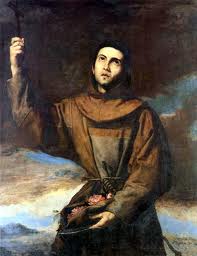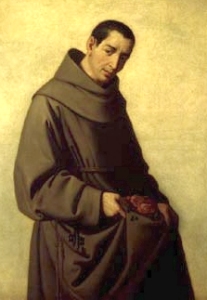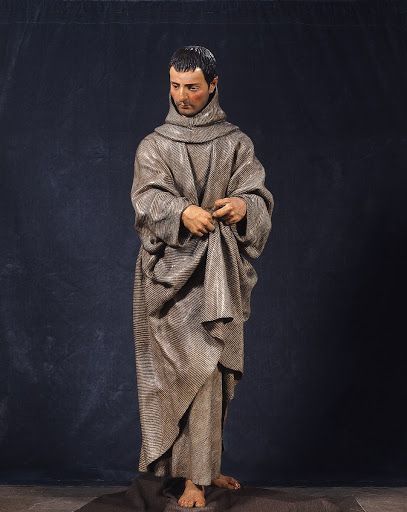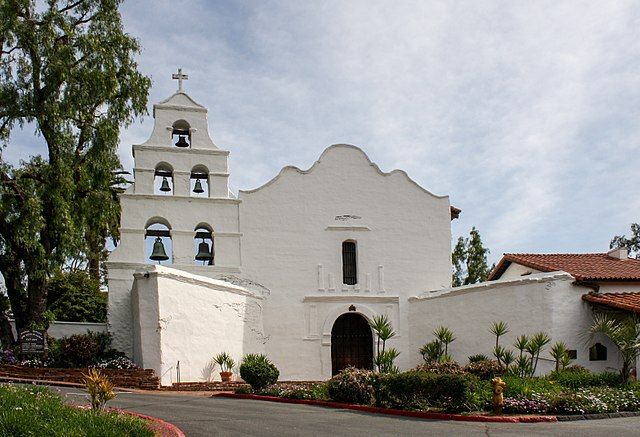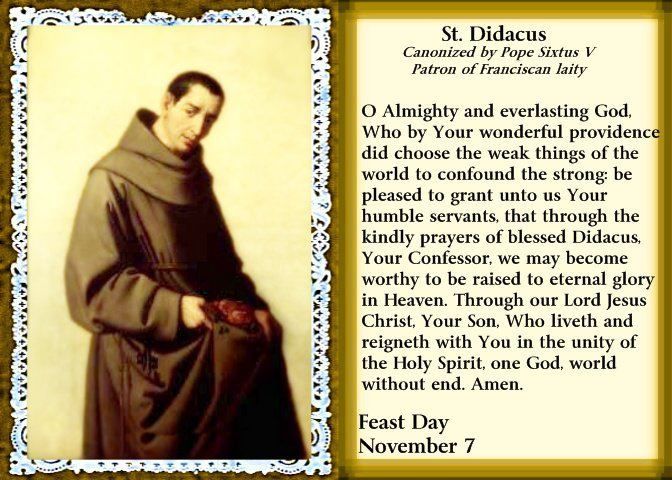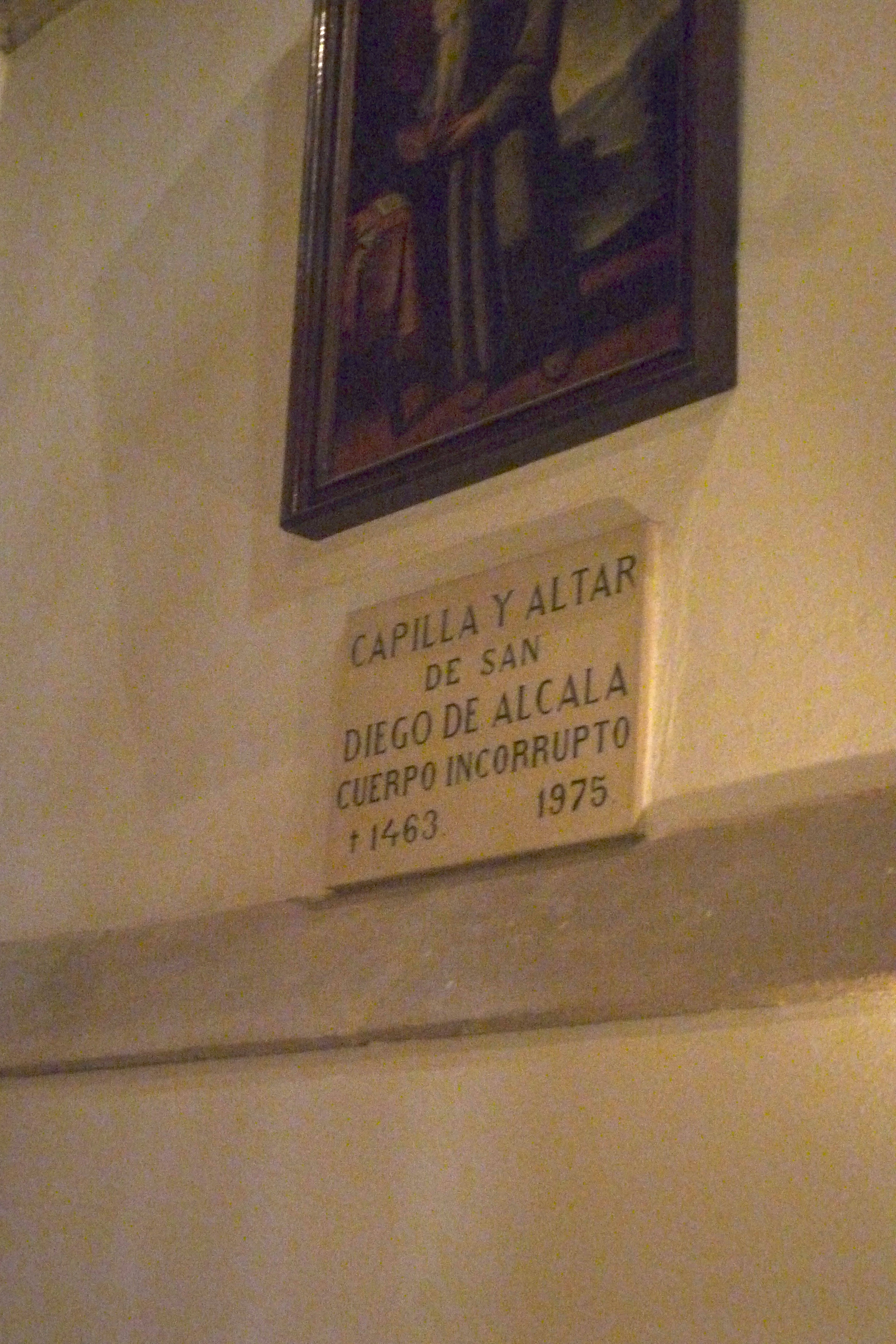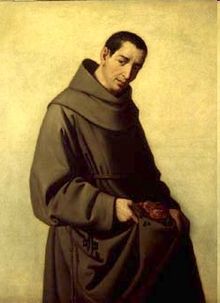Didacus was born c. 1400 into a poor but pious family in the small village of San Nicolás del Puerto in the Kingdom of Seville. As a child, he embraced the hermit life and, later, placed himself under the direction of a hermit priest living not far from his native town. He then led the life of a wandering hermit. Feeling called to the religious life, he applied for admission to the Observant (or Reformed) branch of the Order of Friars Minor at the friary in Albaida and was sent to the friary in Arruzafa, near Córdoba, where he was received as a lay brother.
During his years living in that location, he journeyed to the villages in the regions surrounding Córdoba, Cádiz and Seville, where he would preach to the people. A strong devotion to him still exists in those towns.
Didacus was canonized by Pope Sixtus V in 1588, the first after a long hiatus following the Reformation, and the first of a lay brother of the Order of Friars Minor. His feast day is celebrated on 13 November, since 12 November, the anniversary of his death, was occupied, first, by that of Pope Saint Martin I, then by that of the Basilian monk and Eastern Catholic bishop and martyr, Josaphat Kuntsevych. Until 1969 the Franciscans celebrated his feast day on 12 November, In the United States the feast day is celebrated on 7 November, due to the feast of St. Frances Xavier Cabrini.
Didacus is the saint to whom the Franciscan mission that bears his name, and which developed into the City of San Diego, California, was dedicated. He is thereby the patron of the Roman Catholic Diocese of San Diego.
The Spanish painter Bartolomé Estéban Murillo is noted for painting several representations of Didacus of Alcalá.
The first European to visit the region was explorer Juan Rodríguez Cabrillo, sailing under the flag of Castile but possibly born in Portugal. Sailing his flagship San Salvador from Navidad, New Spain, Cabrillo claimed the bay for the Spanish Empire in 1542, and named the site "San Miguel".
In November 1602, Sebastián Vizcaíno was sent to map the California coast. Arriving on his flagship San Diego, Vizcaíno surveyed the harbor and what are now Mission Bay and Point Loma and named the area for the Catholic Saint Didacus, a Spaniard more commonly known as San Diego de Alcalá. On November 12, 1602, the first Christian religious service of record in Alta California was conducted by Friar Antonio de la Ascensión, a member of Vizcaíno's expedition, to celebrate the feast day of San Diego.
Read more:
https://en.wikipedia.org/wiki/Didacus_of_Alcalá
https://es.wikipedia.org/wiki/Diego_de_Alcalá
https://en.wikipedia.org/wiki/San_Diego
Didacus was born c. 1400 into a poor but pious family in the small village of San Nicolás del Puerto in the Kingdom of Seville. As a child, he embraced the hermit life and, later, placed himself under the direction of a hermit priest living not far from his native town. He then led the life of a wandering hermit. Feeling called to the religious life, he applied for admission to the Observant (or Reformed) branch of the Order of Friars Minor at the friary in Albaida and was sent to the friary in Arruzafa, near Córdoba, where he was received as a lay brother.
During his years living in that location, he journeyed to the villages in the regions surrounding Córdoba, Cádiz and Seville, where he would preach to the people. A strong devotion to him still exists in those towns.
Didacus was canonized by Pope Sixtus V in 1588, the first after a long hiatus following the Reformation, and the first of a lay brother of the Order of Friars Minor. His feast day is celebrated on 13 November, since 12 November, the anniversary of his death, was occupied, first, by that of Pope Saint Martin I, then by that of the Basilian monk and Eastern Catholic bishop and martyr, Josaphat Kuntsevych. Until 1969 the Franciscans celebrated his feast day on 12 November, In the United States the feast day is celebrated on 7 November, due to the feast of St. Frances Xavier Cabrini.
Didacus is the saint to whom the Franciscan mission that bears his name, and which developed into the City of San Diego, California, was dedicated. He is thereby the patron of the Roman Catholic Diocese of San Diego.
The Spanish painter Bartolomé Estéban Murillo is noted for painting several representations of Didacus of Alcalá.
The first European to visit the region was explorer Juan Rodríguez Cabrillo, sailing under the flag of Castile but possibly born in Portugal. Sailing his flagship San Salvador from Navidad, New Spain, Cabrillo claimed the bay for the Spanish Empire in 1542, and named the site "San Miguel".
In November 1602, Sebastián Vizcaíno was sent to map the California coast. Arriving on his flagship San Diego, Vizcaíno surveyed the harbor and what are now Mission Bay and Point Loma and named the area for the Catholic Saint Didacus, a Spaniard more commonly known as San Diego de Alcalá. On November 12, 1602, the first Christian religious service of record in Alta California was conducted by Friar Antonio de la Ascensión, a member of Vizcaíno's expedition, to celebrate the feast day of San Diego.
Read more:
https://en.wikipedia.org/wiki/Didacus_of_Alcalá
https://es.wikipedia.org/wiki/Diego_de_Alcalá
https://en.wikipedia.org/wiki/San_Diego



